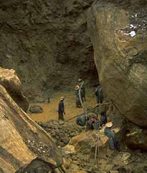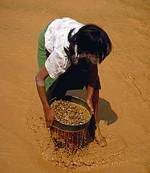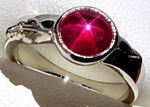Ruby Info
Back to Ruby
Because of its pretty color, hardness, transparency, and rarity rubies belong to the most valuable gemstones since thousands of years. It belongs to the multicolored family of the mineral corundum, the second-hardest mineral after diamond. The red color of the ruby is caused by the element chrome within the crystal structure. All corundums with a different color are called sapphires.
History
Corundum (ruby and sapphire) is known since the Bronze Age, and esteemed because of its hardness and color. The name "ruby" has its roots in the Latin word rubens = red. The most beautiful and oldest rubies come from northern Myanmar, the Mogok region, a valley ("Valley of the Rubies") surrounded by high mountains.
Already B.C. rubies had a superior status in the cultures of India, Egypt, Greek, and Romans.
During the Middle Age all red gemstones were called "Karfunkel" stones. One couldn't distinguish between rubies, spinels, and garnets. These red gemstones were commonly accepted as "stones of life and love". Such a red stone should protect its owner from the devil and the plague. It should give power, bravery, and dignity to its owner.
Around 1800 one could distinguish rubies from other red gemstones. In course of this development some "rubies" were identified as less valuable.
In 1848 Gaudin created the first artificial ruby crystals. High-quality artificial crystals were produced by August Verneuil (1856-1913) in 1892 with his flame fusion process (publication in 1902).
Formation and Resources
 |
| Inn Chauk Mine * |
 |
| Stone washing * |
Rubies are to be found in all continents except Antarctica (until now).
A lot of rubies which were originally embedded in the rock were washed out by erosion (influence of rain, frost, wind, organic acids etc), and washed by surface runoff water to the valleys. Therefore rubies can be found together with other gemstones in the scree of former and recent rivers ("alluvial deposits").
The up to 0.5 m thick alluvial deposits in Sri Lanka are only 1 - 10 m below the surface so that the ruby-rich mud can be digged in pits. Then the rubies are separated from the wothless mud and scree.
* Photo by kind permission of © www.ruby-sapphire.com, Richard W. Hughes.
Besides the old mines in Mogok another location in Myanmar is famous for its ruby deposits: Mong Hsu in the northeast of the country. This deposit, which is known since the 1990ies, delivers still today stones with a violet to black nucleus (with a bright edge). The dark nucleus can be changed by heat treatment into a beautiful deep ruby red. These stones usually have a weight of 0.5 - 3 ct.
Rubies with a slightly violet red are mined in Vietnam, near the Chinese border. Stones from Thailand show a slightly brownish, deep red. Rubies from Sri Lanka are commonly light red. Other Asian deposits are in the Hunza Valley in northern Pakistan, in Cashmere, Tajikistan, Laos, Nepal, India (Mysore and Orissa), and Afghanistan. Since the 1960ies more and more stones come from Africa, especially from Kenya and Tanzania. They have a beautiful strong color which varies from light to dark red. Most of these rubies are, like stones from other worldwide deposits, only of average quality.
Color
The color of a ruby is the most important quality criterium. Its transparency is less important. The color of a ruby can tell about its origin (see above). A "Burma ruby" means its unique top color: a rich, full red with a slightly blueish hue. This color is usually called "pigeon blood red", sometimes "Burma red". A ruby's color should not change in artificial or natural light. If a ruby shows the top color it must not come from Myanmar.
Stars
 |
| Exclusive Star Ruby * |
* Photo by kind permission of © www.ahernbrucker.com, Bob Brucker.
Quality and Value
Inclusions (which still prove the genuineness of the stone) don't have a big influence on the value as long as they don't reduce the transparency or are visible through the top facet ("table").
The cut is also an important quality criterium. Only a perfect cut can emphasize the beauty of a gemstone. A bad cut always lowers the value.
⇐ Intro Page ⇐ Gemstones ⇐ Ruby